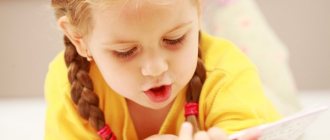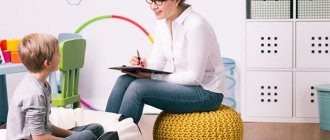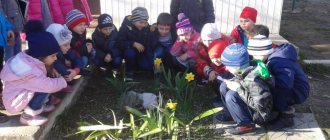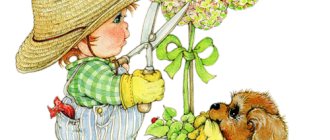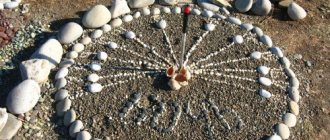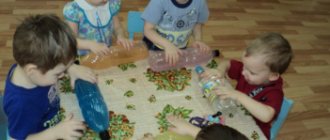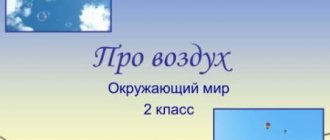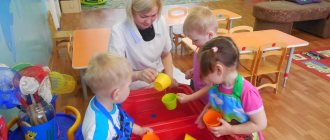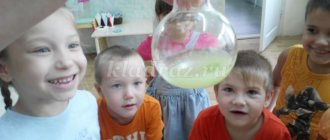Maria Savchenko
Experimental activities in the preparatory group. How to create a rainbow
Introduction
Every person at least once in his life admired a natural miracle - a rainbow . Many people have probably noticed that rainbows usually appear after rain. a rainbow many times , I wanted to know what a rainbow and how it appears, whether it is possible to get a rainbow artificially at home.
Purpose of the study: to find out whether it is possible to get a rainbow at home .
The object of study is the natural phenomenon of the rainbow .
The subject of the study is the types of rainbows and the possibility of obtaining them artificially.
Research problem: how to create different types of rainbows at home ?
Research objectives:
1. Find out what a rainbow and how it appears.
2. what types of rainbows exist in nature and is it possible to obtain them artificially?
3. Conduct experiments on obtaining a rainbow at home .
Hypothesis:
Let's assume that a rainbow can be obtained by replacing the sun's rays:
1. artificial light - lamp,
2. using water and felt-tip pens.
3. using Skitels
I have chosen will allow you to see a rainbow at home .
Basic methods: literature study, observation, experiment.
1.Relevance:
How does a rainbow ?
Since my senior year I have known the saying “Every hunter wants to know where the pheasant sits. From the initial letters of these sayings, I remembered the names and sequence of colors of such an unusual and beautiful natural phenomenon as a rainbow . Why does such a beautiful, and even colorful, picture appear in the air? Together with my teacher, we looked for the answer to this question in the encyclopedia, the Internet, and watched educational cartoons about rainbows . We learned that rainbows can be seen near waterfalls, fountains, and sprinklers.
Conclusion: a rainbow appears in sunny weather during rain, when the sun's rays pass through raindrops.
2. What types of rainbows exist .
a rainbow in the encyclopedia , I decided to find out what other rainbows exist .
A winter rainbow is a very rare phenomenon, because the refraction of sunlight occurs not in water droplets, but in ice crystals.
Hazy or white rainbow
It appears when a faint fog consisting of small droplets is illuminated by sunlight.
Red rainbow
In the last five or ten minutes before sunset, all the colors of the rainbow except red begin to disappear and finally only a single red arc remains.
Practical part
Rainbow is a miracle of nature . Is it possible to create this miracle yourself , at home? I decided to try this and conducted several experiments together with my teacher.
Experience No. 1 “ Creating a rainbow at home ”
Invisible ink
Invisible ink consists of colorless or faintly colored substances that become bright under certain processes: heating, exposure to light or a chemical developer.
For such ink, you can use regular milk, a solution of baking soda in a 1:1 ratio, or lemon juice. Take a brush or cotton swab, soak it in liquid and write something on paper. When the surface dries, the inscription will disappear. To develop it, you need to heat the paper - for example, iron it or bring it to a candle flame. The ink becomes visible because organic substances - proteins, carbohydrates, acids - decompose under the influence of elevated temperatures to form products colored yellow or brown.
How to explain "Rainbow" to preschoolers
An interesting lesson should be completed by explaining the properties of water. The teacher can tell the children that the denser the material - paper compared to a napkin - the slower it gets wet. Therefore, the dots from felt-tip pens take longer to spread.
The description of the “Rainbow in a Glass” experiment for children in the second version includes the following explanation: light consists of a full spectrum of colors, and with the help of a mirror it breaks up into its component parts.
In the third experiment, you need to tell that the more sugar or salt is dissolved in a glass, the denser the liquid becomes. This is why the colors don't mix.
DIY lava lamp
Image: Bystrov/Shutterstock
A simple experience that kids will love as they have a lamp filled with colored liquid that looks like hot lava. You will need a glass jar, a flashlight and a few ingredients that are found in every kitchen.
Take a tablespoon of baking soda and pour it into the jar so that the powder covers the bottom. Then pour sunflower oil there. In a separate small container, mix vinegar with food coloring. Turn on the light, place the jar on top and pour the colored vinegar into it.
Ready! Colored bubbles will alternately sink to the bottom and rise to the neck of the jar under the influence of carbon dioxide, which is released when soda and vinegar interact. They will not be able to merge with the oil due to different densities.
Description of the experience
For many experiments, ingredients that are found in any home are enough. Rainbow in a glass is an experience for children that will introduce them to the properties of water. This theme combines three different experiences that can be carried out in a kindergarten group or at home. They do not require special devices or reagents, and the participants will love the multi-colored result of the trick. The first experiment reveals the concept of water density, the second - the absorbency of paper, and the third - the refraction of light.
A description of the “Rainbow in a Glass” experiment for children can be found in video format; its preparation requires a little time and gouache or food coloring of several colors.
Colored fire
By changing the chemical composition of the burning substances, you can change the shades of the flame itself. Table salt and baking soda help turn the fire yellow. Shades of blue can be produced by copper chloride, selenium, boron and methane. The green color comes from copper, the crimson color comes from potassium chloride, and the red color comes from lithium chloride and calcium salts.
To avoid starting a fire at home, take a simple copper wire, make a ring at the end and dip it in a solution of table salt, and then bring it to the burning burner. The flame will briefly turn yellow-orange. And the easiest way to get blue is to turn on a gas burner. A blue light will light up on the stove.
Rainbow experimentally
In order to make sure that there really are seven colors in the rainbow, and to investigate this natural phenomenon, we conducted a series of experiments. (Appendix 3)
Experiment 1. Artificial rainbow
Required material:
A container of water, a sheet of white paper, a flashlight, a mirror.
Progress of the experiment:
Pour water into the container and lower the mirror to the bottom. We direct the light of the flashlight onto the mirror. The reflected beam of light must be “caught” on the paper. Due to the refraction of the ray, a rainbow appears on the sheet.
Explanation:
A ray of light consists of several colors; when it passes through water, it is decomposed into its component parts - the seven colors of the rainbow.
Experiment 2. Rainbow soap bubbles
Required material:
Container with soapy water, device for blowing bubbles.
Progress of the experiment:
We take the device, dip it in a container of soapy foam and blow out the bubbles.
You can see a seven-color rainbow on the bubbles flying in the air.
Explanation:
Rays of light hitting the bubble are refracted and produce beautiful rainbow colored rings, which Isaac Newton was the first to study.
Experiment 3. Decomposition of white light into a spectrum using a CD
Required material:
CD, white paper, flashlight.
Progress of the experiment:
Let's take a disk. Let's point a flashlight at it so that rays of light fall on its mirror surface. We direct the light using a disk onto a white sheet of paper. We change the tilt of the CD, and then we can see many “rainbow” patterns.
Explanation:
Light is refracted on the mirror surface of the disk, similar to the refraction of sunlight in a drop of water. That's why we can see a rainbow.
Experiment 4. How to get white from a Rainbow
Required material:
A paper circle painted in seven colors of the rainbow; match - axle.
Progress of the experiment:
We make an axis from a match in the center of the paper circle. We begin to rotate quickly. Instead of a colored circle, we will see a white one.
Explanation:
The human eye cannot see each color separately on a rapidly rotating circle, and for it all colors merge into one white color.
Experience 5. Rainbow on the phone
Required material:
Telephone, table lamp, CD.
Progress of the experiment:
We shine a lamp on the mirror surface of the disk. Turn on the camera on your phone and point it at the disk. A rainbow appears over the entire surface of the disk.
Explanation:
The phone's camera, like our eye, perceives light. The disk splits the white light of a flashlight into seven colors of the spectrum. Therefore, we can observe a rainbow on the mirror surface of the disk through the phone camera.
Conclusion
At the beginning of our work, we made the assumption that a rainbow in nature appears only after rain and has seven colors.
While studying the literature, we found out that raindrops can divide white into seven colors of the spectrum, but only when the sun is shining.
In the course of practical experiments, we found that there are several ways to experimentally form a rainbow, and that a rainbow actually has seven colors: red, orange, yellow, green, blue, indigo and violet.
Therefore, the following conclusions can be drawn:
- Rainbows are a natural phenomenon, the study of which requires a lot of effort and is very interesting.
- The main condition for the appearance of a rainbow in nature is the presence of sunlight and rain.
- Obtaining a rainbow experimentally allows for a more detailed study of this rainbow.
The practical part of this work is that by acquiring information about a previously unstudied topic, you can not only enrich your own knowledge, learn to obtain knowledge from additional sources, analyze the material received, but also share your results with peers who, in our opinion, benefit from this topic will be interesting.
Thanks to such work, activity in the cognitive sphere of activity increases, which is the main factor for the development of the student’s personality.
Bibliography
- Dal V.I. Explanatory dictionary of the Russian language. Modern version. - M.: ZAO Publishing House EKSMO - Press, 2000. - 736 p.
- Zubkova N.M. A cart and a small cart of miracles. Experiments and experiments for children. – St. Petersburg: Rech, 2006.-64 p.
- Levkievskaya E. E. Myths of the peoples of the world. - M.: Astrel, 2000. - P. 90. - 528 p.
- New encyclopedic dictionary / Under the general. ed. acad. K.K. Arsenyeva. - St. Petersburg: Publishing house F. A. Brockhaus and I. A. Efron, 1911-1916. - T. 26.
- Newton I. Optics or treatise on reflections, refractions, bendings and colors of light / Translation by S. I. Vavilov - 2nd ed. - M.: State. Publishing house of technical and theoretical literature, 1954. - P. 131. - 367 p.
- Ozhegov S.I., Shvedova N.Yu. Explanatory dictionary of the Russian language: 80,000 words and phraseological expressions / Russian Academy of Sciences. Institute of Russian Language named after. V. V. Vinogradova. — 4th ed., supplemented. - M.: Azbukovnik, 1999. - 944 p.
- Yakovleva M.A. Fun science experiments for kids and adults. Experiments in the room. – M.: Eksmo, 2012. – 64 p.
Appendix 1. Newton's Color Spectrum
Rainbow in a glass
Image: Lu Mikhaylova / Shutterstock
This is a simple experiment that a child can do on their own. Take four glasses, pour three tablespoons of water into them and add a few drops of dye (each glass has its own dye).
Then pour a spoonful of sugar into the first container, two spoons of sugar into the second, and so on. Then take another glass and fill it with clean water. Carefully pour the liquid from the first four glasses into it, observing the order (take the contents of the first glass first, the second – in the second, and so on). As a result, in the fifth container you will get a “rainbow”. Liquid of different colors will not mix because you have changed its density by using sugar.
Preparatory stage
To conduct the “Rainbow in a Glass” experiment in kindergarten, the teacher can learn a rhyme with the group that helps them remember the order of the colors of the rainbow. This will be the main spell. Let the kids taste the water, decide what color it is, add a little color and mix. They will see that the liquid completely changes color. Experimentation will teach children to be careful when handling water, develop fine motor skills and reasoning skills.
What will you need for the experiment?
To demonstrate the Rainbow in a Glass experiment for preschoolers, some simple preparations are required. Each participant must have the following set on the table:
- granulated sugar or salt, about 0.5 kg;
- 6 plastic cups (more is possible);
- food coloring or gouache 5 colors;
- warm water;
- syringe without needle;
- napkin and sheet of thick cardboard;
- colored markers;
- small mirror;
- flashlight.
Children may need help mixing ingredients carefully and maintaining proper proportions.
Hot Ice
In this experiment you will be able to make ice that does not cool anything, but, on the contrary, releases heat. You need to take 0.5 liters of an 80% aqueous solution of acetic acid and 440 g of baking soda and mix. The liquid will hiss and foam, so do not add all the vinegar at once - pour it in a little at a time. Continue stirring the created solution until it calms down. As a result of a chemical reaction, sodium acetate is formed.
Add half a glass of water to it and boil for half an hour. The mixture will become clear, the water and carbon dioxide will evaporate, and the sodium acetate will turn into a liquid. Cool it to room temperature. Now dip a stick into the acetate and watch how “hot ice” crystals begin to form upon contact with the rough surface.
Myths about the rainbow
Rainbow is a magnificent colorful phenomenon that has long captured the imagination of people. Looking at a rainbow, you want to believe in miracles and magic. Maybe that's why humanity has associated the rainbow with many myths and legends.
In Christianity, the rainbow symbolized forgiveness, a contract between God and man, a sign that from now on there will be no more global flood.
In the Christian symbolism of the Middle Ages, the three main colors of the rainbow are interpreted as images of the global flood (blue), global fire (red) and the new earth (green).
In China, they believed that the rainbow was a heavenly dragon, the union of Heaven and Earth.
The Western Slavs have a belief that a witch can steal a rainbow and hide it, which means causing drought on the earth.
The Irish leprechaun hides a pot of gold in the place where the rainbow touched the ground.
According to the beliefs of many African peoples, the rainbow is a heavenly snake that serves as a guardian of treasures, and in those places where the rainbow touches the ground, treasure can be found.
And in the mythology of the Australian aborigines, the Rainbow Serpent is considered the patron of water and rain.
Homemade bath bombs
Image: Pavel Kriuchkov / Shutterstock
Take 300 g of baking soda, 150 g of citric acid, 10 ml of essential oil and 5 ml of vegetable oil. Mix the ingredients and add a little water until you can roll it into a ball. For beauty, you can also add food coloring, multi-colored bath salts, and flower petals to the mixture.
Fill a round bomb mold or silicone muffin mold with the mixture and leave for a while. When you lower the bomb into water, the baking soda and citric acid will enter into a neutralizing chemical reaction. At the same time, bubbles of carbon dioxide will begin to be released, which will foam the water.
Progress of the experiment:
I used: a rectangular tray, plain water, a mirror, a table lamp. I poured some water into the tray and lowered the mirror into it at a slight angle. The beam of light from the lamp was directed onto the part of the mirror immersed in water.
By adjusting the tilt of the mirror, I got this rainbow .
Conclusion: As a result, a reflection of all the colors of the rainbow , we were able to get a rainbow at home
conditions.
(Appendix No. 1)
Experiment No. 2 Growing rainbow
Material: plastic cup, napkin, water, markers
Craft slime
Slime is a toy made of a viscous jelly-like material with the properties of a non-Newtonian fluid. To make it yourself, combine 100 ml of water and 100 ml of PVA glue, stir well, add sodium tetraborate (you can buy it at a regular pharmacy) and mix again. As a result of the chemical reaction between polyvinyl acetate and borax, a dense and viscous substance will be obtained.
Take a plastic bag, put this mixture in it, add multi-colored dyes or glitter, knead the mass well and take it out of the bag - your craft slime is ready!
A sincere passion for science from childhood can lead to victories in competitions and olympiads in the future. For example, the Russian team recently received gold medals at the 53rd International Chemistry Olympiad in Tokyo. The winners included students from Moscow and Yekaterinburg.
The Olympics took place from July 25 to August 2, the competitions were held remotely. Participants from 79 countries competed in knowledge of chemistry.
The meaning of the word "rainbow" in encyclopedic dictionaries
From the Explanatory Dictionary of the Russian Language by S.I. Ozhegov. , we learned that:
A rainbow is a multi-colored arc in the sky, formed as a result of the refraction of sunlight in raindrops.
According to the New Encyclopedic Dictionary of Brockhaus and Efron:
Rainbow is a well-known optical phenomenon in the atmosphere; observed when the sun illuminates a sheet of falling rain and the observer is between the sun and the rain. This phenomenon appears in the form of one, or less often, two concentric light arcs drawn in the sky from the direction of falling rain and colored flowers.
The inner, most often visible arc is colored red on the outer edge and violet on the inner edge; Between them, in the usual order of the solar spectrum, lie the colors: red, orange, yellow, green, blue and violet. The second, less frequently observed arc lies above the first, is usually more weakly colored, and the order of the colors in it is reversed.
According to V. Dahl's dictionary:
Rainbow is a modified version of the word "rayduga", or God's arc.
